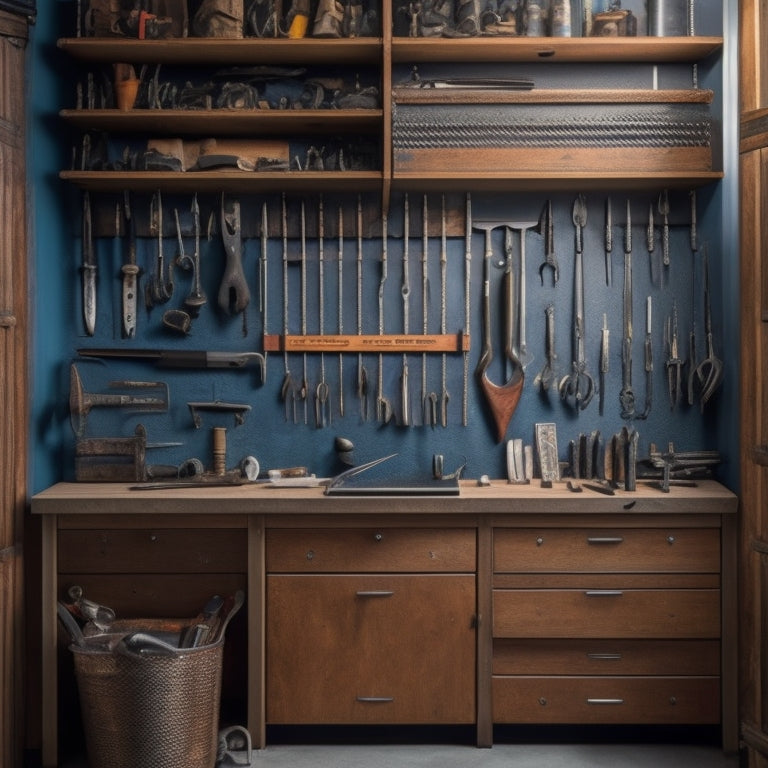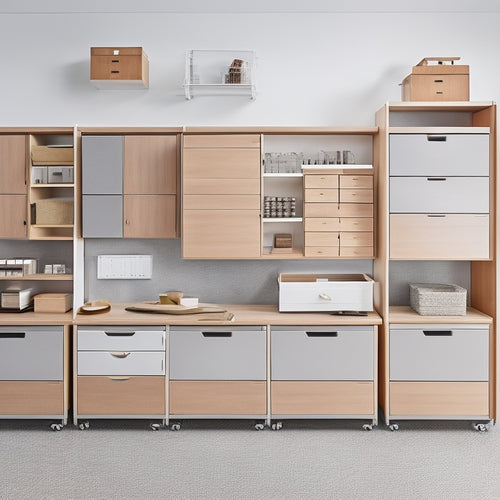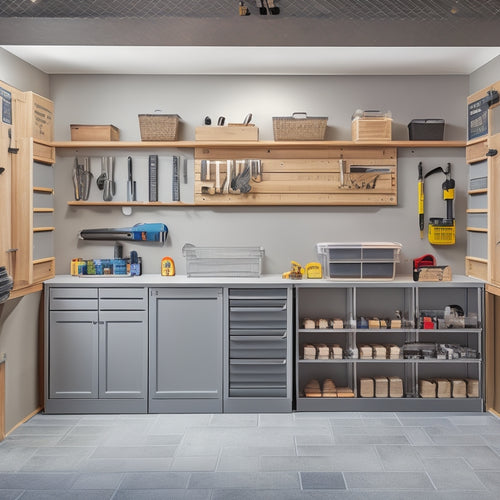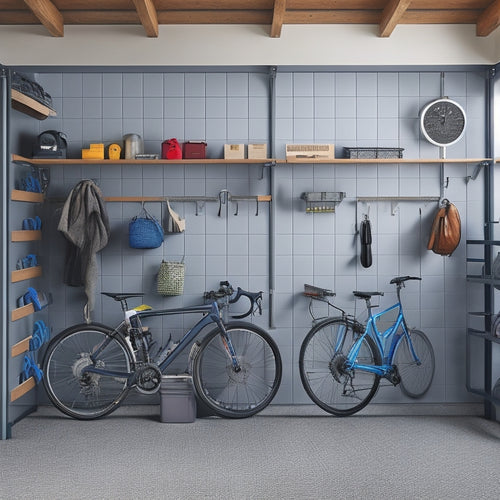
Organize Your Tools Into a Cabinet Tool Organizer
Share
You're about to reshape your cluttered workspace into a productivity powerhouse by organizing your tools into a cabinet tool organizer that enhances efficiency, saves time, and improves safety. Start by evaluating your available space and tool quantity to choose the right cabinet size. Then, implement a tool classification system, such as grouping fasteners, cutting tools, and power tools, and use storage options like bins, baskets, and hooks customized to specific tool types. As you design your cabinet layout, consider tool frequency, workspace layout, and aesthetic preferences. With a well-planned organizer, you'll be well on your way to a more organized, efficient workspace – and there's more to investigate to help you perfect your setup.
Key Takeaways
- Evaluate available space and tool quantity to choose the right cabinet size for efficient storage and reduced clutter.
- Implement a tool classification system, such as grouping by type or function, to enhance organization and accessibility.
- Utilize storage options like bins, baskets, and hooks tailored to specific tool types to maximize space and reduce disorganization.
- Design a cabinet layout that considers tool frequency, workspace movement, and aesthetic preferences for optimal functionality.
- Install organizers like pull-out shelves, drawer dividers, and labels to create a customized and maintainable tool storage system.
Benefits of a Cabinet Organizer
Within the confines of your workshop or garage, a cluttered tool cabinet can quickly become a hindrance to productivity. You waste precious time searching for the right tool, and the risk of accidents increases when tools are scattered all over the place. That's where a cabinet organizer comes in. By installing one, you'll reap several benefits that will revolutionize your work process.
Firstly, you'll enjoy space efficiency. A well-organized cabinet means you can store more tools in a smaller area, freeing up important space for other projects or equipment. This is especially vital in cramped workshops or garages where every inch counts.
Secondly, you'll experience significant time savings. With a cabinet organizer, you can find the tool you need in seconds, getting you back to work quickly. This translates to increased productivity and a better work-life balance.
Furthermore, a tidy cabinet reduces the likelihood of accidents caused by tripping over tools or equipment, ensuring a safer working environment.
Choosing the Right Cabinet Size
You'll need to evaluate two key factors when choosing the right cabinet size: the available space in your workshop or garage, and the amount of tools you need to store.
Cabinet size options range from compact units that fit under a workbench to large, freestanding models that can hold hundreds of tools.
Cabinet Size Options
Choosing the right cabinet size is essential to maximize your tool storage space. You'll want to evaluate the dimensions of the area where the cabinet will be placed, as well as the types and quantities of tools you need to store. A cabinet that's too small will lead to clutter and inefficiency, while one that's too large may waste precious space.
When selecting a cabinet size, reflect on the following options:
| Cabinet Size | Description |
|---|---|
| Compact (24"W x 36"H x 12"D) | Ideal for small workshops or tight spaces, storing essential tools like hammers and screwdrivers. |
| Standard (36"W x 48"H x 18"D) | Suitable for most workshops, holding a wide range of tools, including power tools and accessories. |
| Large (48"W x 60"H x 24"D) | Perfect for large workshops or commercial use, storing heavy machinery and bulkier equipment. |
| Custom | Designed to fit specific needs, custom cabinets can be modified to unique spaces or tool collections. |
Tool Storage Capacity
Efficiency begins with a thorough assessment of your tool storage needs. You must consider the types and quantities of tools you need to store, as well as the frequency of use for each tool. This will help you determine the best tool capacity for your cabinet.
When evaluating tool storage capacity, think about the size and shape of your tools. Will you need dedicated compartments for larger items like power tools or will smaller bins suffice for hand tools and accessories?
Consider the storage efficiency of different cabinet sizes and configurations. Will a compact cabinet with multiple drawers provide better storage density, or will a larger cabinet with adjustable shelves offer more flexibility?
You should also think about your workflow and how you'll be accessing your tools. Do you need quick access to frequently used items or can less-used tools be stored in harder-to-reach areas?
Tool Organization Strategies
You'll want to start by implementing a tool classification system, grouping similar tools together by type or function, to make them easier to find and access.
Next, you'll need to decide on tool storage options, such as bins, baskets, or hooks, that fit your specific tool types and cabinet layout.
Tool Classification Systems
A well-organized tool cabinet relies on a solid tool classification system, which is the backbone of any effective tool organization strategy. As you create your tool classification system, consider the following approaches to categorize your tools:
| Tool Category | Description | Example Tools |
|---|---|---|
| Fasteners | Tools used to join or hold materials together | Hammers, screwdrivers, pliers |
| Cutting | Tools used to cut or shape materials | Saws, utility knives, bolt cutters |
| Measuring | Tools used to measure distances, sizes, or quantities | Tape measures, levels, calipers |
| Power | Tools powered by electricity or batteries | Drills, sanders, impact wrenches |
| Hand | Tools operated manually, without power | Wrenches, pliers, hammers |
You can further refine your tool classification system by implementing color coding or label systems. For instance, you can assign a specific color to each tool category or label each tool with its corresponding category. This will enable you to quickly identify and locate tools, ensuring you work efficiently and safely. By implementing a solid tool classification system, you'll be able to maintain a clutter-free tool cabinet and reduce the risk of accidents.
Tool Storage Options
With your tool classification system in place, it's time to investigate the various tool storage options that will keep your tools organized and within reach.
You'll want to evaluate a combination of storage solutions to maximize your tool cabinet's potential. Portable storage containers, such as bins and totes, are ideal for storing small parts and accessories, keeping them organized and portable.
Wall-mounted organizers, like pegboards and hooks, provide easy access to frequently used tools, keeping them off the floor and out of the way.
When selecting tool storage options, assess the size and weight of your tools, as well as the frequency of use. Heavy-duty tools, like power tools and machinery, may require dedicated shelving or cabinets, while smaller tools, like hand tools and accessories, can be stored in drawers or on shelves.
Designing Your Cabinet Layout
Designing your cabinet layout requires careful consideration of your tool collection and workflow. You'll want to think about the tools you use most frequently and how you can organize them for easy access.
Consider the layout of your workspace and how you move around it – this will help you determine the most efficient layout for your cabinet.
When planning your layout, think about the storage aesthetics you want to achieve. Do you prefer a clean and minimalist look, or are you okay with a more cluttered but functional design?
Consider the size and shape of your tools, as well as any specific storage requirements they may have. For example, do you need to store long-handled tools, like hammers or screwdrivers, or smaller items like nuts and bolts?
Layout considerations should also include the height and depth of your cabinet, as well as any obstructions, such as pipes or electrical outlets.
Essential Tools to Store
Behind every well-organized tool cabinet lies a thoughtful selection of essential tools. As you plan your cabinet's contents, consider the hand tools you use most frequently, such as pliers, wrenches, and screwdrivers.
You'll also want to store power tools like drills, saws, and sanders. Measuring instruments like tape measures, levels, and calipers are must-haves for accurate work.
Don't forget maintenance supplies like lubricants, cleaning solutions, and protective coatings. Safety gear, including gloves, goggles, and a first-aid kit, is vital for protecting yourself on the job.
Specialty tools, like pipe wrenches or tile cutters, should be stored alongside repair kits for specific tasks.
Organize these essentials into categories and store them in labeled storage bins. This will help you quickly find what you need and prevent clutter from building up.
Maximizing Vertical Storage Space
Now that you've curated your collection of essential tools, it's time to think strategically about how to store them. You want to make the most of your cabinet's vertical space to guarantee efficient storage and easy access to your tools.
Begin by grouping similar tools together, such as hammers, screwdrivers, and pliers. This will help you visualize how to allocate space within your cabinet. Consider using stackable bins, shelves, or pegboards to maximize your cabinet's vertical space. These will allow you to store tools of varying sizes, keeping them organized and within reach.
Label each bin or shelf to guarantee you can quickly find the tool you need. Additionally, think about the tools you use most frequently and store them at eye level or near the front of the cabinet for easy access. Less frequently used tools can be stored higher up or towards the back.
Installing Cabinet Organizers
With your tool collection organized and categorized, you're ready to implement a cabinet organizer system that will keep your tools within easy reach.
To begin, measure the interior of your cabinet carefully to determine the ideal placement of your organizers. Consider installing pull-out shelves or drawers to provide easy access to frequently used tools. These features will help prevent strain and injury from bending or reaching.
Next, use drawer dividers to separate and categorize your tools within each drawer. This will prevent tools from becoming jumbled and make it easier to find what you need quickly. Be sure to label each divider so you can quickly identify the contents.
When installing your cabinet organizers, verify they're securely fastened to the cabinet to prevent them from tipping or falling. This is especially important if you have heavy tools or equipment.
Maintaining Your Organized Cabinet
About five minutes each week can make a significant difference in maintaining your organized cabinet. By dedicating a small amount of time to regular maintenance, you'll guarantee your tools remain easily accessible and your workspace stays safe.
To maintain your organized cabinet, focus on the following tasks:
-
Dust and clean shelves: Use a soft-bristled brush or a microfiber cloth to remove dust and debris from shelves and tool holders. This prevents the buildup of dust, which can lead to slippery surfaces and accidents.
-
Wipe down tools: After each use, wipe down tools with a dry cloth to remove dirt, grime, and moisture. This prevents rust and corrosion, guaranteeing your tools remain in good condition.
-
Reorganize as needed: Periodically review your tool organization and reorganize as needed. This guarantees that frequently used tools are easily accessible and that your cabinet remains clutter-free.
Tips for Customization Success
You've invested time and effort into organizing your tool cabinet, and now it's time to make it truly yours by personalizing it to your specific needs. This is where you get to modify your cabinet to fit your workflow, making it even more efficient and safe.
First, assess your tool collection and identify the items you use most frequently. Consider installing custom drawer dividers to separate and categorize your tools. This will prevent clutter from building up again and guarantee you can quickly find what you need.
Next, think about the tools you need to access quickly, such as pliers, screwdrivers, or wrenches. Magnetic tool strips can be a great addition, allowing you to store these tools on the side of your cabinet or on a pegboard, keeping them within easy reach.
Remember to measure your cabinet's dimensions carefully before making any customizations to assure a seamless fit.
With a little creativity and planning, you can create a tool cabinet that's customized to your unique needs, increasing your productivity and reducing frustration.
Frequently Asked Questions
Can I Customize a Cabinet Organizer to Fit My Specific Tool Collection?
You can definitely customize a cabinet organizer to fit your unique tool collection by specifying custom dimensions, ensuring your tools are easily accessible and safely stored, and maximizing tool accessibility to enhance productivity and reduce accidents.
How Do I Prevent Rust and Corrosion in My Tool Cabinet?
You'll prevent rust and corrosion in your tool cabinet by using rust prevention methods like silicone-based sprays and corrosion-resistant materials like stainless steel or powder-coated shelves, ensuring your tools stay safe and functional.
Are Cabinet Organizers Suitable for Small Workshops or Garages?
You think you need a massive workshop to justify a cabinet organizer? Think again! Even in small spaces, you'll appreciate the space efficiency and customizable storage solutions that help you stay organized and safe.
Can I Use a Cabinet Organizer for Non-Tool Storage Needs?
You can repurpose a cabinet organizer for non-tool storage needs, like kitchen storage or craft supplies, by adjusting the shelves and compartments to fit your specific items, ensuring everything is easily accessible and safely stored.
Are There Any Specific Safety Considerations for Cabinet Organizers?
When selecting a cabinet organizer, you'll want to prioritize safety features, such as secure latches and stable shelves, and guarantee material durability to prevent collapses or spills that could lead to injuries or damage.
Conclusion
With your cabinet tool organizer in place, you've tamed the chaos, and your tools are now at your beck and call, like a well-oiled machine. You've built a stronghold against clutter, where every tool has its designated place, just like a precision-crafted Swiss watch. Now, go forth and conquer your projects with ease, knowing that your trusty tools are waiting, like loyal soldiers, ready to be deployed at a moment's notice.
Related Posts
-

Modular Tool Storage Systems for Small Spaces
You can optimize your small workspace by leveraging modular tool storage systems that intelligently employ vertical s...
-

Essential Steps for Garage Storage System Design
You're about to change your cluttered garage into an organized haven by following a structured approach to garage sto...
-

Key Features of a Garage Wall Hanging System
You're looking for a garage wall hanging system that's built to last and adapts to your needs. Look for systems made ...


